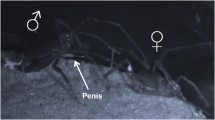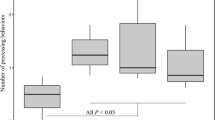Abstract
Many aspects of lobster (Homarus americanus) social behavior have been shown to be regulated by chemical signals. Female lobsters can determine the sex of sheltered conspecifics from a distance, and will approach and attempt to enter male-occupied shelters. We investigated (1) if female attraction to male-occupied shelters and entering decisions are based upon chemical signals, particularly male urine signals, and (2) if male dominance status and female molt stage influence these female behaviors. Sheltered dominant males were fitted with urine catheters, which collect urine and prevent its release into the environment. We found that males increased urine output in response to female entering attempts. Blocking male urine release significantly reduced the incidence of female shelter approach and the time spent attempting to enter. Artificial release of male urine in the presence of a catheterized male restored female approach but not time spent attempting to enter, while artificial urine release alone did not induce either behavior. Females approached any single male, but seemed to prefer to enter shelters occupied by more dominant males. Premolt and intermolt females differed in their behaviors: premolts showed more interest in approaching dominant male shelters without much effort to enter, while intermolts appeared less likely to approach but more motivated to attempt to enter shelters. This study suggests that both intermolt and premolt female lobsters use one or more chemical signals from sheltered males for location and evaluation of potential mates. Male urine appears to carry compound(s) important for both location and entering decisions, although nonurine chemical or other sensory signals are also implicated during close-up mate evaluation.
Similar content being viewed by others
REFERENCES
Aiken, D. E. 1973. Proecdysis, setal development, and molt prediction in the American lobster (Homarus americanus). J. Fish. Res. Bd. Can. 30:1337–1344.
Atema, J. 1985. Chemoreception in the sea: Adaptations of chemoreceptors and behavior to aquatic stimulus conditions. Soc. Exp. Biol. Symp. 39:387–423.
Atema, J. 1986. Review of sexual selection and chemical communication in the lobster, Homarus americanus. Can J. Fish. Aquat. Sci. 43:2283–2290.
Atema, J., and Cowan, D. F. 1986. Sex-identifying urine and molt signals in lobster (Homarus americanus). J. Chem. Ecol. 12:2065–2080.
Atema, J., and Engstrom, D. G. 1971. Sex pheromone in the lobster, Homarus americanus. Nature 232:261–263.
Atema, J., and Voigt, R. 1995. Behavior and sensory biology, pp. 313–348, in J. R. Factor (ed.). The Biology of the Lobster, Homarus americanus. New York, Academic Press.
Atema, J., Jacobson, S., Karnofsky, E., Oleszko-Szuts, S., and Stein, L. 1979. Pair formation in the lobster, Homarus americanus: Behavioral development, pheromones and mating. Mar. Behav. Physiol. 6:277–296.
Atema, J., Breithaupt, T., Levay, A., Morrison, J., Mallidis, M., and Edattikaran, M. 1999. Urine pheromones in the lobster, Homarus americanus: Both males and females recognize individuals and only use the lateral antennule for this task. Chem. Senses 24:615–616.
Bouchard, S., Sainte-Marie, B., and McNeil, J. N. 1996. Indirect evidence indicates female semiochimicals release male precopulatory behaviour in the snow crab, Chionoecetes opilio (Brachyura: Majidae). Chemoecology 7:39–44.
Breithaupt, T., Lindstrom, D. P., and Atema, J. 1999. Urine release in freely moving catheterised lobsters (Homarus americanus) with reference to feeding and social conditions. J. Exp. Biol. 202:837–844.
Bushmann, P., and Atema, J. 1996. Nephropore rosette glands of the lobster Homarus americanus: Possible sources of urine pheromones. J. Crust. Biol. 16:221–231.
Bushmann, P., and Atema, J. 1997. Shelter sharing and chemical courtship signals in the lobster, Homarus americanus. Can. J. Fish. Aquat. Sci. 54:647–654.
Charlton, R. E., and CardÉ, R. T. 1990. Behavioral interactions in the courtship of Lymantria dispar (Lepidoptera: Lymantriidae). Ann. Entomol. Soc. Am. 83:89–96.
Cowan, D. F. 1991. The role of olfaction in courtship behavior of the American lobster Homarus americanus. Biol. Bull. 181:402–407.
Cowan, D. F., and Atema, J. 1990. Moult staggering and serial monogamy in American lobsters, Homarus americanus. Anim. Behav. 39:1199–1206.
Darwin, C. 1871. The Descent of Man and Selection in Relation to Sex. Murray, London.
Dunham, P. J. 1978. Sex pheromones in Crustacea. Biol. Rev. 53:555–583.
Dunham, P. J. 1988. Pheromones and behaviour in Crustacea, pp. 375–392, in H. Laufer and G. H. Downer (eds.). Endocrinology of Selected Invertebrate Types. Liss, New York.
Dunham, P. J., and Skinner-Jacobs, D. 1978. Intermolt mating in the lobster (Homarus americanus). Mar. Behav. Physiol. 5:208–214.
Dussourd, D. E., Harvis, C. A., Meinwald, J., and Eisner, T. 1991. Pheromonal advertisement of a nuptial gift by a male moth (Utethesia ornatrix). Proc. Natl. Acad. Sci. U.S.A. 88:9224–9227.
Eales, A. J. 1974. Sex pheromone in the shore crab Carcinus maenas, and the site of its release from females. Mar. Behav. Physiol. 2:345–355.
Gleeson, R. A. 1980. Pheromone communication in the reproductive behavior of the blue crab, Callinectes sapidus. Mar. Behav. Physiol. 7:119–134.
Gleeson, R. A. 1991. Intrinsic factors mediating pheromone communication in the blue crab, Callinectes sapidus, pp. 17–32, in R. T. Bauer and J. W. Martin (eds.). Crustacean Sexual Biology. New York, Columbia University Press.
Guenther, C. M., and Atema, J. 1998. Distribution of setae on the Homarus americanus lateral antennular flagellum. Biol. Bull. 195:182–183.
Hoffman, R. S., Dunham, P. J., and Kelly, P. V. 1975. Effects of water temperature and housing conditions upon the aggressive behavior of the lobster Homarus americanus. J. Fish. Res. Bd. Can. 32:713–717.
Jaccard, J. 1983. Statistics for the Behavioral Sciences. Wadsworth, Belmont, CA.
Jones, D. R., and Hartnoll, R. G. 1997. Mate selection and mating behaviour in spider crabs. Estuarine Coast. Shelf Sci. 44:185–193.
Karavanich, C., and Atema, J. 1998a. Olfactory recognition of urine signals in dominance fights between male lobsters, Homarus americanus. Behaviour 135:719–730.
Karavanich, C., and Atema, J. 1998b. Individual recognition and memory in lobster (Homarus americanus) dominance. Anim. Behav. 56:1553–1560.
Karnofsky, E. B., Atema, J., and Elgin, R. H. 1989. Field observations of social behavior, shelter use, and foraging in the lobster, Homarus americanus. Biol. Bull. 176:239–246.
MAYNARD-SMITH, J. 1991. Theories of mate choice. Trends Ecol. Evol. 6:146–151.
Rowland, W. J., Robb, C. C., and Cortwright, S. A. 1990. Chemically-mediated mate choice in red-spotted newts: Do males select or just detect females? Anim. Behav. 39:811–813.
Ryan, E. R. 1966. Pheromone: evidence in a decapod crustacean. Science 151:340–341.
Waddy, S. L., and Aiken, D. E. 1990. Intermolt insemination, an alternative mating strategy for the American lobster (Homarus americanus). Can. J. Fish. Aquat. Sci. 47:2402–2406.
Weaver, M., and Atema, J. 1998. Hydrodynamic coupling of lobster antennule motion to oscillatory water flow. Biol. Bull. 195:180–182.
Zahavi, A. 1975. Mate selection-a selection for a handicap. Theor. Biol. 53:205–214.
Author information
Authors and Affiliations
Rights and permissions
About this article
Cite this article
Bushmann, P.J., Atema, J. Chemically Mediated Mate Location and Evaluation in the Lobster, Homarus americanus. J Chem Ecol 26, 883–899 (2000). https://doi.org/10.1023/A:1005404107918
Issue Date:
DOI: https://doi.org/10.1023/A:1005404107918




